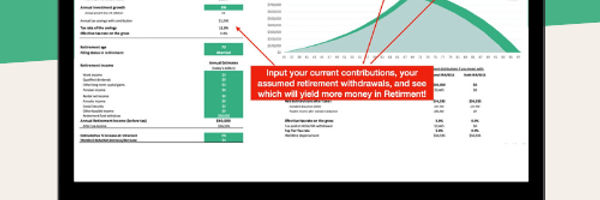This calculator allows you to see the difference between a Roth IRA versus a traditional IRA in terms of annual income. This Roth vs. Traditional IRA calculator allows you to figure out how much retirement income you can expect from each of three types of retirement accounts on an after-tax basis.

Roth IRA or 401k? This template will answer your questions.
With this template, you will get:
All DFY, simply add your details
Charts for comparison and clear answer
Easily update for any year (2023, 2024, 2025, etc…)

Calculator Definitions
The variables used in our online calculator are defined in detail below, including how to interpret the results.
Your Current Age (Years)
This is your current age in years.
Expected Retirement Age (Years)
This is your expected retirement age.
Life Expectancy (Years)
This is your life expectancy when you reach your estimated retirement age. Many people mistakenly believe that life expectancies are in the range of 75 years of age. However, that figure applies only at birth. For example, at age 65, the average life expectancy is 83 years of age.
Age of IRA Fund (Years)
This is the age of your IRA fund, stated in years. The calculator needs to know this information because it attempts to compute your tax liabilities based on how long the fund has existed. In other words, the calculator uses the fund's age and the expected annual return to figure out how much money was deposited in the account and the approximate appreciation in the fund's value. If you do not yet have an l IRA, then simply enter zero.
Current Amount in IRA Fund ($)
If you currently have an IRA fund, then enter that amount here. If you have not yet opened an account, then you can enter zero.
Annual Contribution to IRA ($)
This is how much you'd like to contribute to your IRA account each year. By increasing or decreasing your annual contribution, you can see the impact on your IRA fund balance at retirement. This calculator ignores the immediate tax benefit of a deductible IRA account because we believe the investor is more interested in retirement income then immediate tax benefits offered by tax deductible accounts.
Expected Annual Return on Fund (%)
This is the annual rate of return you expect to realize on this fund between now and your expected retirement age. Once again, by increasing or decreasing the expected annual return, you can see the impact on your fund's balance.
Expected Tax Rate in Retirement (%)
The expected tax rate in retirement is used to compute the taxes owed on income received. Most individuals expect their overall incremental tax rate to be lower in retirement.
Traditional IRA Fund Balance at Retirement ($)
This is the expected balance you will have in your traditional IRA account at retirement if you make the annual contributions to the fund each year, and the expected annual return is achieved.
Before and After Tax Contributions
This calculator returns two sets of results for traditional IRA accounts: one for before-tax contributions, and one for after-tax contributions. Depending on your income levels, and whether or not you have a retirement plan at work, you may be able to fund your traditional IRA with tax deductible (before tax) contributions. You may want to check out our article on traditional IRA contribution rules.
Total After Tax Contributions ($)
The calculator provides you with an estimate of your total after-tax contributions; if you're eligible, and decide to fund your account with after-tax dollars. This estimate is based on the total contributions, plus the calculator attempts to model funds already in your account by using the expected rate of return and the fund's age.
Taxable Fund Balance at Retirement ($)
If you've taken tax deductions for your traditional IRA deposits, then the entire fund balance is taxable. If you're funding this account with after-tax dollars, then only the appreciation in the fund's value is taxable upon withdrawal.
Annual Income at Retirement ($ / Year)
This is the annual income you can expect to receive from your Roth or traditional IRA account, using your life expectancy as a guide. Keep in mind that minimum withdrawals may apply with traditional IRA accounts.
Taxes Owed on Income ($ / Year)
The taxes owed on income are shown to demonstrate the differences between the tax liability for before and after-tax contributions. With a Roth IRA, there are no taxes owed on withdrawals.
Net Income after Taxes ($ / Year)
By comparing the net income after taxes for before-tax contributions and after-tax contributions to a traditional IRA, you can get a feel for the impact of each strategy. As previously mentioned, traditional IRAs also have income eligibility and phase out rules that may apply.
Comparison Roth vs. Traditional IRA ($ / Year)
This line in the calculator allows you to compare income from a traditional vs. Roth IRA account. To be fair, we are making the comparison between a Roth IRA and traditional IRA for deposits that are made on an after-tax basis.
Roth vs. Traditional IRA Funds Calculator
Disclaimer: These online calculators are made available and meant to be used as a screening tool for the investor. The accuracy of these calculations is not guaranteed nor is its applicability to your individual circumstances. You should always obtain personal advice from qualified professionals.



.jpg)
.jpg)